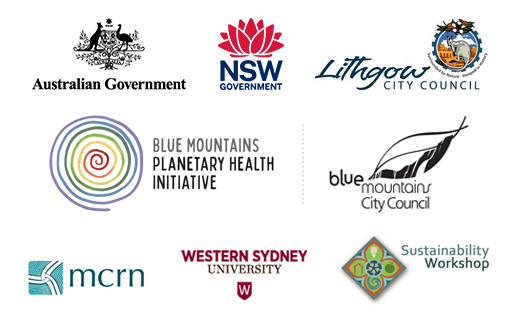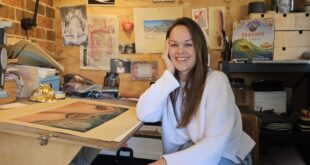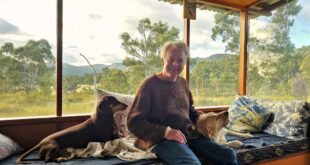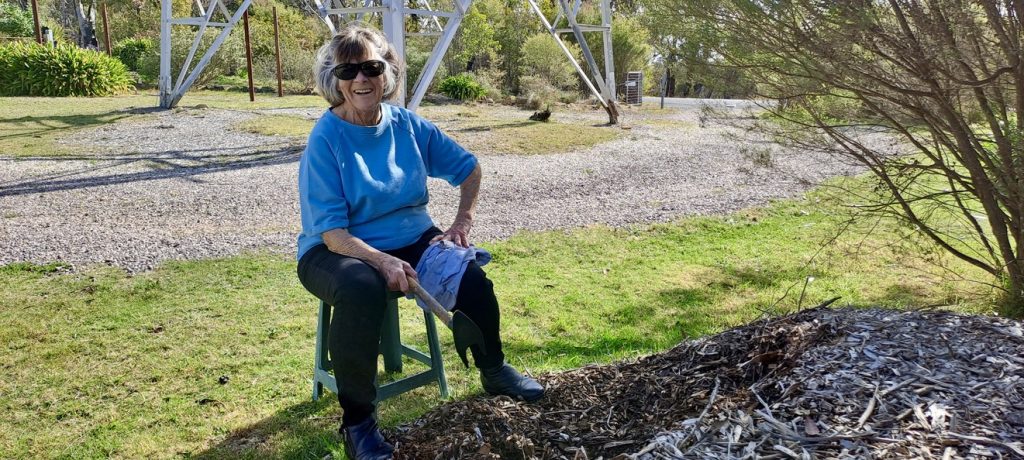
Margaret Gough on her ‘patch’ (Hamish Dunlop)
Margaret Gough ran a WIRES animal refuge for more than two decades, was District Commissioner for Scouts in the Blue Mountains, and coordinated the Lithgow Community Centre for a decade. Her home burnt in Mount Victoria during the 2013 fires, but she’s rebuilt and is now more prepared. She continues to nurture the diverse life on ‘her patch’.
Key Points:
- Margaret has installed water tanks, a pump and sprinkler systems to protect her home from fire.
- Providing water for wildlife is critical, especially ahead of this coming El Nino summer.
- For Margaret, nurturing both the human and more-than-human communities she lives with has been the recipe for a fortunate life.
Share this article:
When Margaret Gough picks up my call she’s out in the garden. “You’ve caught me making worms!” she says with gusto. I enjoy this turn of phrase. Normally people say they’re making compost and the worms are helping. But like many things Marg has done in her life, she understands the interconnectedness of all our actions as she nurtures others, human and non-human alike.
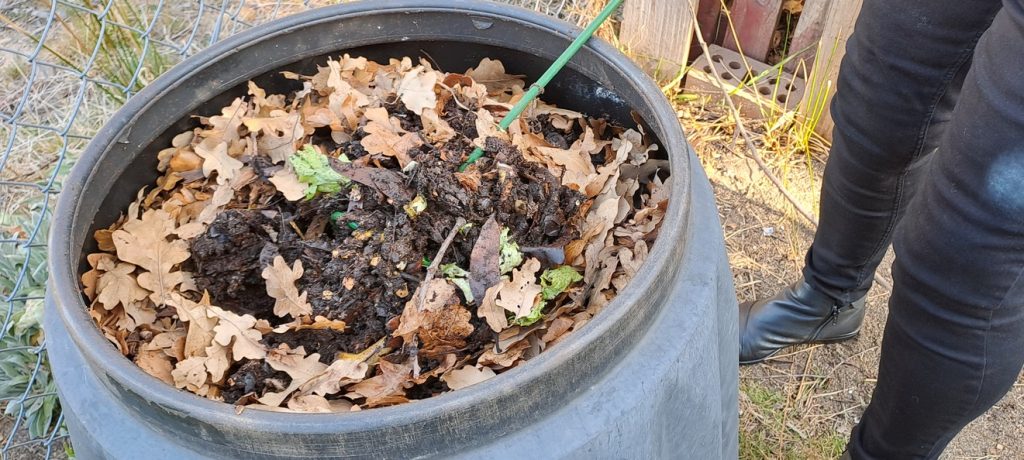
One of Margaret’s compost bins. (Hamish Dunlop)
She’s been on her Mount Victoria “patch” under the Endeavour Energy powerlines for 40 years. Her way of living and working with the land has been informed by constant observation. She leans forward and her eyes light up as she tells me about the wallaroos that sometimes dance on the mulch pile at dusk.
There are two female red-necked wallabies with young in their pouches that come up to drink from the water baths. Native topknot pigeons are nesting in the neighbour’s property. There is a poetry and a story in what she sees and how she responds.
A story of fire
In 2013, 11 homes burnt in Mount Victoria. One of them was Margaret’s. The Rural Fire Service (RFS) defended her house that day. Later, one of the firefighters told her a fire ball smashed through a perspex window. It leapt over various items of furniture including Marg’s piano and engulfed the upper interior of the house. RFS volunteers were able to enter the home and quell the blaze. The piano got soaked and stayed wet in a shipping container for months until the house was partially rebuilt. It’s sitting near the kitchen now – shiny and with family photos saved from the fire.
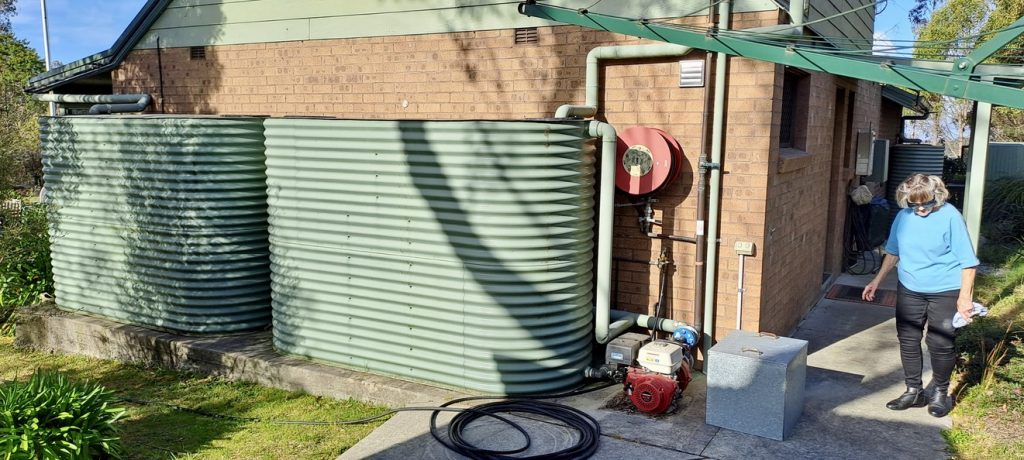
Margaret next to her water tanks and the petrol-driven water pump. (Hamish Dunlop)
Post 2013, she had a sprinkler system installed on the house. It’s attached to two water tanks and there is a petrol generator for the pump. The individual sprinklers sit along the roof apex and along the edges of the guttering. “Water shoots out 20 feet when it’s running.” she says. “It’s important to have the generator and the system tested to make sure it works when it’s needed. This is something the RFS can assist with.” I ask if she can start it herself. She’s not able to but says all the neighbours are involved in fire mitigation in one way or the other. “There are people who can help when it’s needed.”
(NB. The scientific understanding of bushfire sprinklers is still evolving. Due to the inherent variability in bushfire behaviour and potential for unforeseen outcomes to occur under extreme conditions it is advisable to get expert advice when designing a system.)
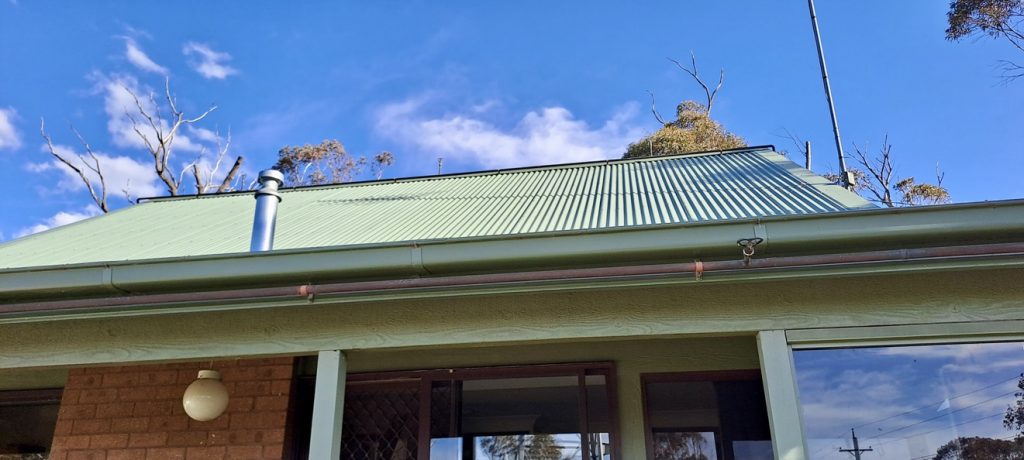
Sprinklers along the roof ridge and below the guttering. (Hamish Dunlop)
Nurturing wildlife
Margaret ran a WIRES animal refuge for more than two decades. This ended in 2013 when her home was burnt by the fire that came across Mount York Road. Before then, it was a triage to release system. Wallaroos, kangaroos and wallabies would enter at the front shed. As they recovered, Margaret would move them further east towards the bush. The enclosures would get larger and more open until finally the end gate was open. At this stage they had to forage for their own food, but water always remained available. She looked after possums and birds too.
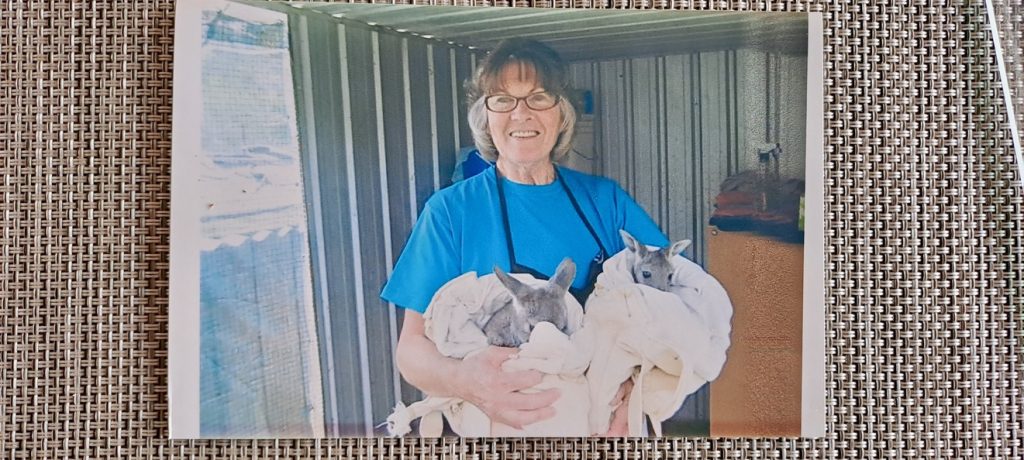
A photo of Margaret when she was running the refuge. (Hamish Dunlop)
At the top of the property there are water baths for the marsupials and birds. The ground is covered in scat of different sizes, shapes and compositions. Marg identifies the wallaroos, wallabies and kangaroos by their droppings. “In 2019/20, I had animals fleeing the fires coming here. Some of them arrived with singed fur and burnt paws and climbed straight into the water baths.” While we’re looking at Margaret’s composting set up, a wallaroo quietly hops into the open enclosure below the nursery.

One of the possum enclosures with the nursery and hutch on the left. (Hamish Dunlop)
“A male,” whispers Marg. “There’ll be a female at some stage.” I try to get a photo, but my steps cause the animal to camouflage itself in dead bracken. “The bracken is important for the swamp wallabies too,” Marg says. “They need to keep their eyes out of direct sunlight.” As I retreat, she explains, “Even the ones I’ve nurtured are wild.”
A soft touch
Margaret doesn’t talk about the interconnectedness of all things, but her approach is undeniably ecological. This year, arborists cleared oil-rich tea tree in preparation for the fire season. By doing so they’ve also cleared the way for eastern grey kangaroos and other macropods to traverse their east-to-west pathways.
She collects greywater in a tub in her sink and uses one kettle a day for tea. “Periwinkle is being particularly invasive this year,” she says. “I soak recycled newspaper in greywater. Then I trolley it over to the garden bed and layer it down. I put tea tree mulch on top of that. I won’t ever get rid of it, but this should slow it down,” she says with a smile.
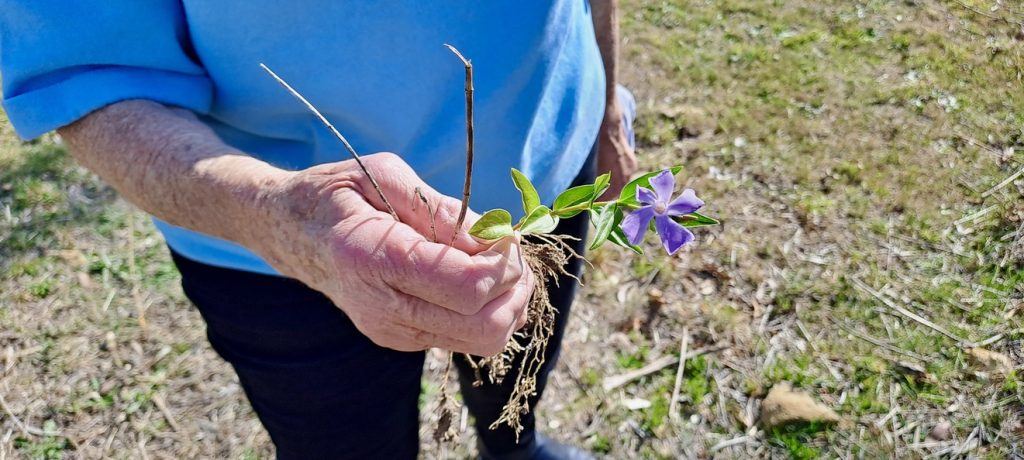
Periwinkle. (Hamish Dunlop)
This is a light approach to weed management. She doesn’t want to use poisons. “There are too many things that get affected in the garden and the soil. A poison-free approach means pollinators and other insects are protected.”
Margaret plants winter roses and other low lying introduced species in her front garden. “These are gorgeous and they’re good for pollinators. They function as a fire mitigation strategy too. Planting them suppresses the bracken that threatens to take over. It’s no good having such combustible material close the house.”
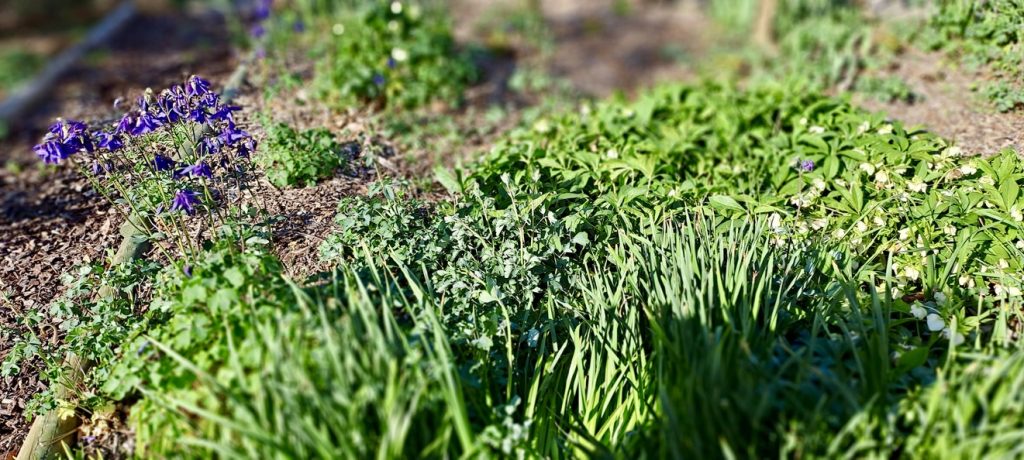
Margaret’s floral garden. (Hamish Dunlop)
By her own assessment, she’s finding work on her two-acre property increasingly “hard yakka.”
“I’m 83 years old. But as I’ve aged, I’ve developed ways to get done what I want to get done. I’ll take the trolley over the grass not the gravel. When I’m filling buckets with mulch, I sit on my trusty stool. I’ve put in paths to make garden access easier and I plant species that I know I can manage. I’m aiming to look after the top acre now and am hoping Endeavour Energy will bring in a machine to turn over the tea tree further down.”
Nurturing people
Margaret’s has been a lifetime of service. She started volunteering at a Scout shop in Liverpool after her children flew the nest. This culminated many years later in her becoming the District Commissioner for Scouts in the Blue Mountains. On her 50th birthday, she started work as the Coordinator of Lithgow Community Centre. Over 10 years, she developed and managed aged-care and disability support services. She fondly recalls how dancing and music were things that people could look forward to.
The community has responded in kind. After the 2013 fire, the RFS helped her sort through the remains of her home. Trades people came and did the best to salvage what remained. She remembers many of them were Scouts. Neighbours helped too and a horticulturist volunteered time to help rebuild and replant her garden. Of all the generosity, there was a standout.
One of the items that got burnt in the fire was Margaret’s Scout blanket. These blankets are covered in badges and patches that tell the history of the owners’ achievements, activities and events they’ve attended. Across a lifetime, they become a rich historical tapestry. One day a friend arrived for tea. Margaret recalls noticing something hanging on her arm. “I was astonished,” she says. “Somehow Carol found every one of the badges and stitched memorabilia I had collected and lost.”

Margaret’s re-created Scout blanket hanging above her kitchen. (Hamish Dunlop)
Margaret continues to work in the community. On Thursdays she helps look after a group of children at the Anglican church in Mount Victoria. “Carol does the games and crafts and I look after the kiosk and provide first aid,” she says. “The first aid is mostly making the children feel safe – it’s a matter of TLC (Tender Loving Care).”
After her house burnt in the 2013 fires, she volunteered at the Salvation Army Citadel in Faulconbridge. “I worked on reception. People would come in and I’d make them comfortable,” she says. “I’d find them a chair and get them a cup of tea or coffee. I could empathise because I was going through the same thing as the people in Winmalee. Volunteering helped me through it.”
Life has returned
While I’m admiring Margaret’s compost bins and worm farm, we see an electric blue-coloured fairy wren and his partner. She is excited by all the life that has come back after 2019/20. She exclaims, “There are buff-banded rails, scores of wattle birds and different species of honey eaters. I love listening to the Kookaburras’ cacophonous racket. They swoop into the gums for lerps and grubs and unsettle newly hatched snakes with their noisy calls. Then it’s a fast pounce and return, followed by a crack – just like a breaking stick.”

Superb Fairy Wren. (Photo by Ash Vigus in Connecting Country)
As we’re finishing up, I’m struggling to put away my notebook. “I’ve just got to write that down!” I say. She laughs and I feel grateful for the time she has spent with me. I’m amazed by all she’s done and all she’s continuing to do. “Not bad for an old girl,” she chuckles. Her lightness belies her inspiring perseverance to respond positively to change.
“I feel fortunate in my lifetime,” she concludes. “Fortunate to be able to suck the goodness out of a bad experience. To me everything has been worthwhile. My life is still as worthwhile as it has ever been.” Looking at me across the table her eyes are incredibly bright; polished I imagine by a life of giving and care.
Take Action:
- Learn more about how you can support wildlife here (link to Tracy’s workshop)
- Learn how Andy Stevenson protected his Mount Victoria property during the fires here
- Learn basic principles for home and landscape design to reduce bushfire risk here and here (Nigel and Sue Bell)
Share this article:
This story has been produced as part of a Bioregional Collaboration for Planetary Health and is supported by the Disaster Risk Reduction Fund (DRRF). The DRRF is jointly funded by the Australian and New South Wales governments.
